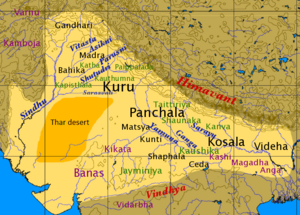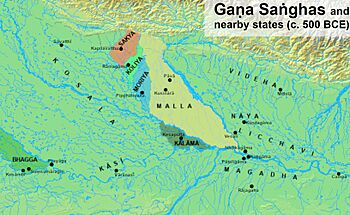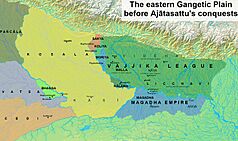Videha facts for kids
Quick facts for kids
Videha
|
|||||||||
|---|---|---|---|---|---|---|---|---|---|
| c. 1100 BCE–c. 7th century BCE | |||||||||

The Kingdom of the Videhas and other kingdoms of the late Vedic period
|
|||||||||

Republican Videha (ruled by Vajjika League) among the Gaṇasaṅghas in the Post-Vedic period
|
|||||||||
| Capital | Mithila, which could either be Janakpur (in present-day Nepal), or Baliraajgadh (in present-day Madhubani district, Bihar, India). | ||||||||
| Common languages | Sanskrit | ||||||||
| Religion | Historical Vedic religion | ||||||||
| Demonym(s) | Vaideha | ||||||||
| Government | Monarchy | ||||||||
| Rājā (earlier) Gaṇa Mukhya (later) |
|||||||||
| Establishment | By Videgha Mathava | ||||||||
| Historical era | Iron Age | ||||||||
|
• Established
|
c. 1100 BCE | ||||||||
|
• Republic Vajjika League dethroned monarchy Viedha dynasty
|
c. 7th century BCE | ||||||||
|
|||||||||
| Today part of | India Nepal |
||||||||
Videha was an ancient tribe of people who lived in the north-eastern part of the Indian subcontinent during the Iron Age. These people were called the Vaidehas.
At first, Videha was a kingdom ruled by a king. Later, it changed into a type of republic called a gaṇasaṅgha. This meant it was ruled by a group of important families, not just one king. This new form of government was known as the Videha Republic. It was also part of a bigger group of states called the Vajjika League.
Contents
Where Was Videha Located?
The Videha kingdom was bordered by rivers and mountains. To the west was the Sadānirā river (today's Gandaki River). To the east was the Kauśikī river (today's Koshi River). The Gaṅgā river was to the south, and the Himālaya mountains were to the north. West of the Sadānirā river was the kingdom of Kosala.
Later, when Videha became a republic, its borders were still the Sadānirā and Kauśikī rivers. However, the republic only covered the northern part of the old kingdom. This larger old kingdom was then called Mahā-Videha, meaning "greater Videha." The Videha Republic was located near the foothills of the Himalaya mountains. This area is now parts of Nepal (the Tarāī region) and northern Bihār, India.
What Does the Name Videha Mean?
The name Videha comes from an older word, Videgha. The capital city of the Vaidehas was Mithilā. This city was named after a Vaideha king called Mithi. Some old texts also call the capital Jayantapura or Vaijanta. The name Videha itself can mean "without walls or ramparts." It was also used to mean "destroyers of walls and ramparts."
The Time of Kings (Monarchy)
The Vaidehas were an Indo-Aryan tribe living in the eastern Gangetic plain. The large Mahā-Videha kingdom was founded around 800 BCE. It was located between the Sadānirā and Kauśikī rivers, the Gaṅgā river, and the Himālaya mountains.
Even though they were Indo-Aryan, the Vaidehas were not fully following the Vedic traditions at first. They lived in a cultural area called Greater Magadha. This area was east of the Gaṅgā-Yamunā rivers. The Vaidehas had close ties with other tribes in this region, like the Kāśya and Kauśalya tribes. Old Indian writings often mentioned them together.
During the early period, from about 900 BCE to 700 BCE, the Vaidehas were ruled by kings. This was the monarchical period. One famous king of Mahā-Videha was Mithila, who gave his name to the capital city.
Later, during the time of King Janaka, the Vaidehas started to follow more Vedic traditions. King Janaka was a big supporter of new ideas about Brahman (a spiritual concept). His main priest, Yājñavalkya, was a student of a wise teacher from another region. King Janaka and Yājñavalkya were important leaders for scholars of their time.
The period when kings ruled Videha lasted for about 150 to 200 years. There were probably up to eight kings during this time.
The Time of Republics
Around the 7th or 6th century BCE, before or during the time of the Buddha, another tribe called the Licchavis took over the Mahā-Videha kingdom. They took control of Mithilā, the capital city.
The Licchavikas peacefully ended the rule of King Janaka's family. They replaced the monarchy with a gaṇasaṅgha system. This meant Videha became a republic ruled by a group of noble families.
The Licchavikas then became very powerful in the region. They moved their main political center to Vesālī. The new Videha Republic, centered around Mithilā, was smaller. Many noble families from Videha moved to Vesālī and joined the Licchavi ruling group. Important people from Videha also got high positions in Vesālī.
The Licchavikas had the most power in the old Mahā-Videha kingdom. The Videha Republic was ruled by an assembly of kshatriya (warrior class) families. This assembly governed under the Licchavika Assembly. The Videha Republic was greatly influenced by the Licchavi.
Videha joined the Vajjika League, which was led by the Licchavi. Videha was an important member, but not as powerful as the Licchavikas or the Mallakas. Videha had some freedom to manage its own affairs, but Licchavi controlled its foreign policy. The Videha Republic had good relations with other members of the Vajjika League.
During the Buddha's lifetime, Videha stopped following Brahmanism and started following Buddhism.
After the Buddha died, the Licchavikas, Mallakas, and Sakyas claimed parts of his remains. The Vaidehas did not claim any because they were under the control of the Licchavikas. They did not have their own independent power.
(Malla shown within the Vajjika League)
Conquest by Magadha
The Licchavikas, who led the Vajjika League (which included Videha), had good relations with their southern neighbor, the kingdom of Magadha. The Magadhī king Bimbisāra was married to a princess from Vesālī.
However, there were sometimes problems between Licchavi and Magadha. For example, they argued over who would get the Buddha's remains after he died.
At one point, the Licchavikas even invaded Magadhī land. Relations between Magadha and Licchavi got much worse after the Licchavikas offended King Bimbisāra.
The problems continued when Ajātasattu, Bimbisāra's son, took over the throne of Magadha after killing his father. The Licchavi supported a revolt against Ajātasattu by his younger step-brother. This step-brother was Bimbisāra's son with another Licchavika princess. The Licchavikas tried to put him on the throne of Magadha.
After this rebellion failed, Ajātasattu tried to make peace with the Licchavikas and the Vajjika League many times. When his peace talks failed, he declared war on the Vajjika League in 484 BCE.
One reason for the war was that the Vajjika League, led by the Licchavikas, would take all the valuable goods from a shared border post. They left nothing for the Magadhīs. Ajātasattu wanted to destroy the Vajjika League in return. He also wanted the land of the old Mahā-Videha kingdom, which was now part of the Vajjika League.
Ajātasattu also disliked the Vajjika League because it was a republic, while Magadha was a kingdom ruled by a king. This was similar to how the ancient Greek kingdom of Sparta disliked the democratic government in Athens.
As an important member of the Vajjika League, the Videha Republic was also in danger from Ajātasattu. It fought alongside the other tribes in the league against Magadha. At first, the Vajjika League's army was too strong for Ajātasattu. He had to use clever plans and tricks for ten years to finally defeat the Vajjika League by 468 BCE.
After this, Magadha took over all the territories of the Vajjika League, including Videha. After Magadha's conquest, there is no more mention of the Vaidehas as an independent group. They became part of the larger Magadha kingdom.
How the Republic Was Organized
Assembly
Like the Licchavikas, the Videha Republic had its own ruling Assembly. The Vaidehas were mainly a kshatriya (warrior) tribe. So, their Assembly was mostly made up of the leaders of the kshatriya families. However, it was smaller than the Licchavika Assembly. Leaders of non-kshatriya families could also join.
For example, brāhmaṇa (priestly class) family heads could be members or influence the Assembly. Since Mithilā was a trading center, rich merchants could also be members or influence decisions. Out of about 84,000 to 100,000 people in Videha, 6,000 heads of kshatriya families were automatically members of the Vaideha Assembly. They were called rājās, meaning "rulers."
The Vaideha Assembly had a meeting place called a santhāgāra. However, it usually met only once a year.
The Head of the Republic (Gaṇa Mukhya)
The Gaṇa Mukhya was like a consul or president. This person was chosen by the citizens. They kept the old title of Videha or Vedeha, meaning "Lord of Videha." Only a kshatriya who had strong support from his family and important people could become Gaṇa Mukhya. To be chosen, a person needed to be a good leader, strong, good at speaking, and popular.
The Gaṇa Mukhya shared power with four other public officers:
- The Gaṇa Mukhya himself.
- An uparājā (Viceroy), who was like a second-in-command.
- A senāpati (General-in-Chief), who led the army.
- A bhaṇḍāgārika (Treasurer), who managed the money.
Council
Since the main Assembly met only once a year, a smaller group called the Council met more often. This Council was the most powerful group for running the daily affairs of the Videha Republic. It was made up of members chosen from the Assembly.
This Council was similar to the Licchavika Council, but smaller. It might have had four rājās: the Gaṇa Mukhya and three other council members. These members were in charge of public administration. They also suggested important ideas to the Assembly, which had to approve them. The Council also met with visitors from other states and made important decisions for the republic.
What Happened After Videha?
After the Gupta period, the names Mithilā and Tirabhukti started to be used for the entire area that was once the Mahā-Videha kingdom.
Videha and Mithilā also appear in later Indian epic stories like the Rāmāyaṇa and the Mahābhārata. For example, the princess Sītā in the Rāmāyaṇa is from Videha. These stories are based on the time when Videha was a kingdom ruled by kings.
Kings of Videha
There were 52 kings, called Janakas, who ruled the Videha dynasty of Mithila:
- Mithi - (founder of Mithila and the first Janaka)
- Udavasu
- Nandivardhana
- Suketu
- Devarata
- Brihadvrata
- Mahavira
- Sudhriti
- Dristaketu
- Haryasva
- Maru
- Pratindhaka
- Kritiratha
- Devamidha
- Vibhuta
- Mahidhrata
- Kirtirata
- Mahorama
- Svarnorama
- Hrasvaroma
- Seeradhvaja (father of Sita)
- Bhaanumaan
- Shatadyumna
- Shuchi
- Oorjanaamaa
- Kriti
- Anjana
- Kurujit
- Arishtanemi
- Shrutaayu
- Supaarshva
- Srinjaya
- Kshemaavee
- Anenaa
- Bhaumaratha
- Satyaratha
- Upagu
- Upagupta
- Svaagata
- Svaananda
- Suvarchaa
- Supaarshwa
- Subhaasha
- Sushruta
- Jaya
- Vijaya
- Rita
- Sunaya
- Veetahavya
- Dhriti
- Bahulaashwa
- Kriti - (last King of Videha or Janaka dynasty. He was removed from power by the public, led by learned men.)
After the fall of the Videha dynasty, the famous Licchavi republic grew powerful in Vaishali. The Mithila region then came under the control of the Licchavi clan, which was part of the Vajji confederacy, around the 8th century BCE.
See also
- Maithils
- Vedic period
- Mithila, India
- Mithila (region)
- History of India
- History of Hinduism
- History of Mithila Region
- Ancient Mithila University
- Janapada and Mahajanapada



